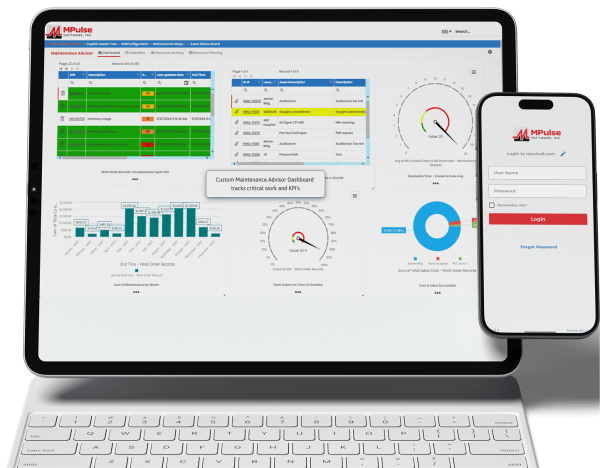Switching to a CMMS can offer numerous benefits in terms of improving maintenance efficiency and reducing costs. However, military and defense contractors often encounter some common concerns with this type of change.
Putting a CMMS solution in place can seem like a daunting task. Defense contractors need to carefully plan the process. Understanding common concerns early on can help to minimize disruptions and streamline the transition.
Table of Contents
Common Concerns about Switching to a CMMS
Consider these potential roadblocks when planning your switch to CMMS software.
Integration with Existing Systems
- It’s likely your organization uses an assortment of systems to capture, store, and report on activities and transactions across the enterprise. One major concern is how well the CMMS will integrate with existing software and systems. Defense contractors often have complex IT infrastructures, and seamless integration with other systems, software, and tools is critical. Remember that while CMMS software holds clear advantages for the maintenance team, other departments can benefit as well.
- New data integration tools make integrating software across departments possible for a CMMS to share and receive data with other applications. Now you can easily link CMMS with other systems, such as ERP and accounting software, predictive maintenance monitors, building automation systems, and more. For example, MPulse DataLink Integration Adapter can meet virtually any data integration need, because it’s compatible with a wide array of file and data exchange formats. For example, you might want to integrate MPulse with spreadsheets, other databases, ERP systems, accounting systems, PLCs, electronic meters, and more.
Data Security
- Security is a paramount concern for defense contractors, given the sensitive nature of their operations. You may worry about the security of data stored in maintenance software, as well as potential vulnerabilities in the software itself that could be exploited by malicious threats. For contractors working on classified projects, the CMMS needs to have the capability to handle and protect classified information appropriately.
- CMMS data is an organizational asset, and it needs to be protected like any other asset. You don’t hand the keys to your office over to just anyone—and you don’t want unauthorized access to your software either. That’s why MPulse supports SAML SSO, enabling its cloud-based CMMS software to integrate with security directories that determine who gets access to what computers, networks, applications, and services. No other third parties are required. Additionally, MPulse Role-Based Access Control helps you prevent unauthorized users from viewing or editing data, gain tighter control over data access, and eliminate unnecessary information.
Compliance and Regulations
- Defense contractors are subject to strict regulations and compliance requirements. They need to ensure that the CMMS they choose complies with these regulations, including International Traffic in Arms Regulations (ITAR) and Export Administration Regulations (EAR) for export-controlled items. Customization of defense contractor maintenance software is the best way to match your organization’s workflows with your maintenance software.
- Defense contracts and regulations can change over time. Contractors need a CMMS that can adapt to these changes and stay compliant. The data you gather in your CMMS software should match what your organization wants to know. For example, if your organization uses special codes or tracks internal data, you need the appropriate tabs and fields in your CMMS database to collect that information. Make sure your software can be customized to meet your specific needs.
Training and User Adoption
- Implementing a new CMMS involves training personnel to use the system effectively. A successful maintenance management program requires well-trained people and a solution set up right to work with your organization’s needs. Resistance to change and the time required for training can be concerns, as can ensuring that all employees are comfortable using the new software.
- CMMS training helps individuals and organizations adapt to change more effectively. Training provides individuals with the opportunity to acquire new skills and improve existing ones, whether that’s technical skills, soft skills, or specialized knowledge relevant to their field or industry. Proper training can enhance an individual’s ability to perform tasks efficiently and effectively, leading to increased productivity. Address any concerns by identifying training options that meet your organization’s goals and budget.
Scalability and Customization
- Defense contractors need a system that can scale as your operations grow or change. Any fluctuations in the number of locations, employees, or service requesters can directly impact your existing systems, which need to scale appropriately. Additionally, military asset management often requires customization of the CMMS to fit specific processes.
- To address these concerns effectively, conduct a thorough evaluation of potential CMMS solutions. Involve key stakeholders in the decision-making process. Finally, develop a robust implementation plan that takes into account the unique needs and challenges of their operations. Ask questions about what you anticipate they’ll need in the future, as well as what they need today.
Anticipating these common concerns can help you accelerate your software implementation and reduce your ramp-up time. Additionally, you can minimize disruptions and achieve a faster return on investment. Additionally, consulting with experts in IT security and compliance can help ensure a smooth transition to a CMMS.
Have questions about switching to a CMMS? We have answers. Contact us for more information. Or get your free trial.






